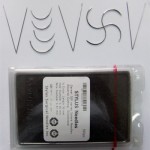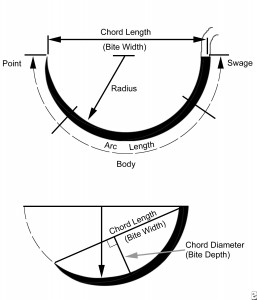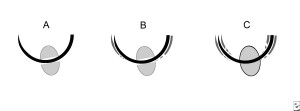Blunt-point needles
Blunt point needles dissect friable tissue rather than cut it. The points are rounded and blunt, ideal for suturing the liver and kidneys. Additionally, blunt needles are being developed for more conventional uses in an effort to reduce needlestick injuries.

Types of suture needles in dentistry
Needle body types include the following:
• Straight body
• Half-curved ski body
• Curved body
• Compound curved body
The body part of the needle incorporates most of the needle length and is important for interaction with the needle holder and the ability to transmit the penetrating force to the point. The needle factors that affect this interaction include needle diameter and radius, body geometry, and stainless steel alloy. These components determine the needle-bending moment, ultimate moment, surgical-yield moment, and needle ductility.
The straight- body needle is used to suture easily accessible tissue that can be manipulated directly by hand. This needle is also useful in microsurgery for nerve and vessel repair. Examples of straight-body needles include the Keith needle, which is a straight cutting needle used for skin closure of abdominal wounds, and the Bunnell needle, which is used for tendon/gastrointestinal tract repair.
The half-curved ski needle is rarely used in skin closure, because it is difficult to handle. The straight portion of the body does not follow the curved point, resulting in an enlarged curved point, which makes the needle difficult to handle.
The curved needle has a predictable path through tissue and requires less space for maneuvering than a straight needle does. The semicircular path is the optimal course for sutures through tissue and provides an even distribution of tension. Body curvature is commonly a one-quarter–inch, three-eighths–inch, half-inch, or five-eighths–inch circle. The three-eighths–inch circle is used most commonly for skin closure. The half-inch circle was designed for confined spaces, and more manipulation by the surgeon is required (ie, increased wrist motion is required).
The compound curved needle curvature was originally designed for anterior segment ophthalmic surgery. The body has a tight 80° curvature at the tip, which becomes a 45° curvature throughout the remainder of the body. A microvascular compound curved needle may also facilitate vessel approximation in microvascular surgery.
Swage
The suture attachment end creates a single, continuous unit of suture and needle; this is known as the swage. The swage may be designed to permit easy release of the needle and suture material (pop-off), and includes the following types:
• Channel
• Drill
• Nonswaged
In a channel swage, a needle is created with a channel into which the suture is introduced, and the channel is crimped over the suture to secure it into place. The diameter of the channel swage is greater than the diameter of the needle body.
In a drill swage, material is removed from the needle end (sometimes with a laser), and the needle is crimped over the suture. The diameter of the drill swage is less than the diameter of the needle body.
Alternatively, in a nonswaged needle, the suture may be passed through an eye, similar to that found in a sewing needle. In a closed-eye configuration, the shape may be round, oblong, or square. In a French (split or spring) eye, a slit is in the end of the needle with ridges that catch and hold the suture in place.
Several disadvantages are associated with the use of a nonswaged needle. Tissue passage of a double strand of suture leads to more tissue trauma. In a swaged needle, the suture is less likely to become unthreaded prematurely. Also, decreased handling helps maintain suture integrity. Swaged sutures are not subject to suture fraying or damage due to sharp corners in the eye of eyed needles.
Needle coating and needle measurements
The needle may be coated with silicone to permit easier tissue passage. The coating helps reduce the force needed to make initial tissue penetration and the frictional forces as the body of the needle passes through the tissue.
The chord length, or bite width, is the linear distance from the point of the curved needle to the swage (bite width). The needle length is the distance measured along the needle from the point to the swage. Needle length, not chord length, is the measurement supplied on suture packages. The radius is the distance from the body of the needle to the center of the circle along which the needle curves (bite depth), and the diameter is considered the gauge or thickness of the needle wire. See the image below.
 Needle–needle holder interaction
Needle–needle holder interaction
The stability of the needle within the needle holder affects needle control and performance. The jaws of the needle holder must be appropriate to the needle size to hold it securely and prevent rocking, turning, and twisting (see the following image). An ovoid cross-section of the needle body often maximizes both the surface contact with the needle-holder jaws and the bending moment of the needle.
 Interaction between the needle holder and suture needle. A: A needle holder of appropriate size for the needle; B: a needle holder that is too large for the needle—pressure applied by the needle holder leads to inadvertent straightening of the suture needle; C: a needle holder that is too small for the needle—the needle rotates around the long axis of the needle holder.
Interaction between the needle holder and suture needle. A: A needle holder of appropriate size for the needle; B: a needle holder that is too large for the needle—pressure applied by the needle holder leads to inadvertent straightening of the suture needle; C: a needle holder that is too small for the needle—the needle rotates around the long axis of the needle holder.